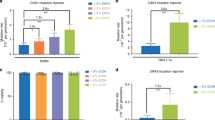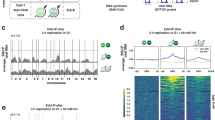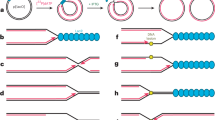Abstract
THYMIDINE starvation is known to be both toxic and mutagenic to various prokaryotes, including Escherichia coli1,2, Bacillus subtilis3 and bacteriophage T4 (refs 4–6). Base excess, as well as base starvation, can also be mutagenic. For instance, Bernstein et al.5 showed that a superabundance of exogenous thymidine (4 mM) produced an increased reversion rate for some T4 amber mutants. In mammalian cells a superabundance of exogenous thymidine is toxic, perhaps by inhibiting DNA synthesis7–9. The mechanism for these effects may be related to the observations that dTTP inhibits the enzymatic reduction of CDP to dCDP by ribonucleoside diphosphate reductase10 and also that thymidine reduces the dCTP pools of Chinese hamster cells to 90% of normal11. We report here that a superabundance of exogenous thymidine is both toxic and highly mutagenic to V-79 Chinese hamster cells but that hydroxyurea, an inhibitor of ribonucleoside diphosphate reductase, is toxic but not mutagenic.
This is a preview of subscription content, access via your institution
Access options
Subscribe to this journal
Receive 51 print issues and online access
$199.00 per year
only $3.90 per issue
Buy this article
- Purchase on Springer Link
- Instant access to full article PDF
Prices may be subject to local taxes which are calculated during checkout
Similar content being viewed by others
References
Coughlin, C. A. & Adelberg, E. A. Nature 178, 531–532 (1956).
Weinberg, R. & Latham, A. B. J. Bact. 72, 570–572 (1956).
Bresler, S., Mosevitsky, M. & Vyacheslavov, L. Nature 225, 764–766 (1970).
Drake, J. W. & Greening, E. O. Proc. natn. Acad. Sci. U.S.A. 66, 823–829 (1970).
Bernstein, C., Bernstein, H., Mufti, S. & Strom, B. Mutat. Res. 16, 113–119 (1972).
Smith, M. D., Green, R. R., Ripley, L. & Drake, J. W. Genetics 74, 393–403 (1973).
Hakala, M. T. & Taylor, E. J. biol. Chem. 234, 126–128 (1959).
Klenow, H. Biochim. biophys. Acta 35, 412–421 (1959).
Morris, N. R. & Fischer, G. A. Biochim. Biophys. Acta 68, 84–92 (1963).
Reichard, P., Canellakis, Z. N. & Canellakis, E. S. J. biol. Chem. 236, 2514–2519 (1961).
Bjursell, G. & Reichard, P. J. biol. Chem. 248, 3904–3909 (1973).
Bradley, M. O. & Sharkey, N. A. Nature 266, 724–726 (1977).
Skoog, L. & Bjursell, G. J. biol. Chem. 249, 6434–6438 (1974).
Walters, R. A., Tobey, R. A. & Ratliff, R. L. Biochim. biophys. Acta 319, 336–347 (1973).
Author information
Authors and Affiliations
Rights and permissions
About this article
Cite this article
BRADLEY, M., SHARKEY, N. Mutagenicity of thymidine to cultured Chinese hamster cells. Nature 274, 607–608 (1978). https://doi.org/10.1038/274607a0
Received:
Accepted:
Issue Date:
DOI: https://doi.org/10.1038/274607a0
This article is cited by
-
Insight into the roles of hypoxanthine and thydimine on cultivating antibody-producing CHO cells: cell growth, antibody production and long-term stability
Applied Microbiology and Biotechnology (2012)
-
Mitotic control of dTTP pool: a necessity or coincidence?
Journal of Biomedical Science (2007)
-
dNTP pools imbalance as a signal to initiate apoptosis
Experientia (1996)
-
Abilities of wild-type and thymidine kinase-deficient Friend mouse erythroleukemia cells to undergo unscheduled DNA synthesis following mutagen treatment
Somatic Cell and Molecular Genetics (1986)
-
Evidence for indirect involvement of thymidine kinase in excision repair processes in mouse cell lines
Somatic Cell and Molecular Genetics (1985)
Comments
By submitting a comment you agree to abide by our Terms and Community Guidelines. If you find something abusive or that does not comply with our terms or guidelines please flag it as inappropriate.



